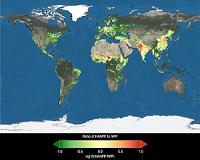 |
Moffett Field CA (SPX) Dec 17, 2010 With the capability to provide valuable information about individual farm fields, vineyards and orchards, NASA satellites soon will provide California growers in the San Joaquin Valley with important information about crop growth, irrigation demands and forecasts, as well as imagery of their fields throughout the growing season. To support irrigation management decisions by agricultural producers, NASA has launched a project that uses the Terrestrial Observation and Prediction System (TOPS), a software application that processes imagery from Earth-observing satellites and delivers new sources of information to California growers. TOPS combines data from NASA satellites with local weather observations to provide information about crop water needs. The project is an example of NASAs efforts to address needs outside the science community, such as water management in California and the western United States. "Growers have the best understanding of how much water is needed for their crops, based on the unique conditions associated with each field," said Forrest Melton, a project scientist at NASA's Ames Research Center, Moffett Field, Calif. "Our goal is to provide additional information from NASA satellites to help growers get the most value out of the water they have available." This new version of TOPS builds on technologies developed by prior NASA-supported research to optimize irrigation management and quality control in California vineyards. The project now is designing new ways to link satellite observations with measurements from wireless sensor networks installed in agricultural fields. By combining these two sources of information, scientists will develop a highly accurate picture of the water balance across each field, providing participating growers with a new source of information to manage their irrigation systems. The prototype system is undergoing beta-testing in collaboration with growers in the San Joaquin Valley. The project uses data from the Landsat program, a series of Earth-observing satellites built and launched by NASA and managed by the U.S. Geological Survey. Landsat satellites have taken digital images of Earths continents and coastal regions for more than three decades, broadening our understanding of natural processes and human-induced changes in the landscape. "Satellites like Landsat have a resolution of about one quarter of an acre, a meaningful scale to growers," said Lee Johnson, a senior research scientist at California State University, Monterey Bay working on the project. "The two Landsat satellites currently operating collect new observations for every location approximately once a week, making the information useful to growers in drawing up irrigation schedules, and for water managers tasked with ensuring that enough water is available to meet the demand from agriculture." Processing the vast volume of satellite data needed to produce information for agricultural producers and water managers across millions of acres of irrigated land in real time is a major challenge. To address this challenge, the project is leveraging the NASA Earth Exchange, a new resource at Ames that brings together global Earth observation datasets and NASA supercomputing resources to support both fundamental and applied research. "With the advanced computing resources at Ames, we can quickly process terabytes of data and make it available to growers almost immediately," says Rama Nemani, a senior research scientist at Ames, and lead scientist for the NASA Earth Exchange project. As residential, industrial, agricultural and environmental demands compete for limited water supplies, new sources of information will help consumers, water managers and policy makers manage water supplies more effectively. NASAs computing and data management infrastructure provides new capabilities to maximize the benefit of water supplies throughout California and the western United States.
Share This Article With Planet Earth
Related Links Ames Earth Observation News - Suppiliers, Technology and Application
 How Hard Are We Pushing The Land
How Hard Are We Pushing The LandWashington DC (SPX) Dec 15, 2010 We may be becoming an ever more technologically advanced society, but we remain as dependent as ever - if not more and more so - on the natural world that surrounds us. That is one takeaway from new NASA research that has found humans are using an increasing amount of the Earth's total land plant production each year for food, fiber, building and packaging materials and biofuels. Thi ... read more |
|
| The content herein, unless otherwise known to be public domain, are Copyright 1995-2010 - SpaceDaily. AFP and UPI Wire Stories are copyright Agence France-Presse and United Press International. ESA Portal Reports are copyright European Space Agency. All NASA sourced material is public domain. Additional copyrights may apply in whole or part to other bona fide parties. Advertising does not imply endorsement,agreement or approval of any opinions, statements or information provided by SpaceDaily on any Web page published or hosted by SpaceDaily. Privacy Statement |